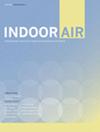Application of Data-Driven Building Information Modeling in the Visual Simulation of Disease Transmission and Route with Pipeline System
IF 4.3
2区 环境科学与生态学
Q1 CONSTRUCTION & BUILDING TECHNOLOGY
引用次数: 0
Abstract
Currently, preventing epidemics is an extremely critical global topic. Using present data to quickly conduct virus simulations is a difficult but interesting problem, especially when real situations are difficult to experimentally demonstrate. In the past, most studies have used package software for disease transmission simulation, but this approach is limited by availability and software cost. Therefore, we propose a visual simulation of disease transmission using building information modeling data and a 3D model using Unity. The results show that the proposed method can effectively predict the probability and route of disease transmission; it also verifies that the vertical pipeline on the floor plane is conducive to the spread of the virus (90%), and disease transmission on the plane gradually expands outward from the starting room and has a higher probability of spreading (80%) from the opposite room. In addition, a vertical pipeline was simulated using a toilet exhaust air ventilation pipeline, from which it can be observed that the adjacent floors have a higher diffusion probability (70%). It has also been confirmed that distance is the primary factor affecting disease transmission. This framework may provide designers and managers further protection against the spread of future epidemics.数据驱动的建筑信息模型在管道系统疾病传播路径可视化仿真中的应用
当前,预防流行病是一个极其重要的全球性课题。利用现有数据快速进行病毒模拟是一个困难但有趣的问题,特别是当真实情况难以通过实验证明时。过去的研究大多采用软件包软件进行疾病传播模拟,但这种方法受到可用性和软件成本的限制。因此,我们建议使用建筑信息建模数据和使用Unity的3D模型来可视化模拟疾病传播。结果表明,该方法能有效预测疾病传播的概率和途径;也验证了地板平面上的垂直管道有利于病毒的传播(90%),平面上的疾病传播从起始房间逐渐向外扩展,从对面房间传播的概率更高(80%)。另外,使用厕所排风通风管道模拟垂直管道,可以看出相邻楼层具有更高的扩散概率(70%)。距离也是影响疾病传播的主要因素。这个框架可以为设计人员和管理人员提供进一步的保护,防止未来流行病的蔓延。
本文章由计算机程序翻译,如有差异,请以英文原文为准。
求助全文
约1分钟内获得全文
求助全文
来源期刊

Indoor air
环境科学-工程:环境
CiteScore
10.80
自引率
10.30%
发文量
175
审稿时长
3 months
期刊介绍:
The quality of the environment within buildings is a topic of major importance for public health.
Indoor Air provides a location for reporting original research results in the broad area defined by the indoor environment of non-industrial buildings. An international journal with multidisciplinary content, Indoor Air publishes papers reflecting the broad categories of interest in this field: health effects; thermal comfort; monitoring and modelling; source characterization; ventilation and other environmental control techniques.
The research results present the basic information to allow designers, building owners, and operators to provide a healthy and comfortable environment for building occupants, as well as giving medical practitioners information on how to deal with illnesses related to the indoor environment.
 求助内容:
求助内容: 应助结果提醒方式:
应助结果提醒方式:


